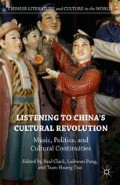Abstract
The 2006 world premiere of the opera The First Emperor was one week away, but the collective spirit of the team was deteriorating. Composed by Tan Dun, The First Emperor was a monumental affair, and it was the first time the Metropolitan Opera at New York had commissioned a composer of Chinese descent. The pressure was high in the rehearsal room, so a break was called. Tian Hao-Jiang, a world-renowned opera singer, was caught in the tension of differing artistic visions among members of the production team, as well as endless revisions. During the break, he sat down at the piano, seeking solace. The tune that came to his fingers was “The East is Red,” the omnipresent anthem from the era of Cultural Revolution. Soon his Chinese colleagues gathered around him. Tian recalled later:
Zhang Yimou, normally so dour, singing and raising his fist to the sky in a gesture familiar to anyone who had been alive during the Cultural Revolution… For the full twenty minutes we sang and sang and sang, one revolutionary song after another, plus set pieces with characteristic poses from the model operas we’d been required to attend during the Cultural Revolution. Wang Chaoge danced on, Zhang Yimou leaped about and gestured, and as I added my own voice, I felt a rush of mixed feelings.
Access this chapter
Tax calculation will be finalised at checkout
Purchases are for personal use only
Preview
Unable to display preview. Download preview PDF.
Notes
Hao-Jiang Tian, Along the Roaring River: My Wild Ride from Mao to the Met (New York: John Wiley, 2008).
The gestures and poses are inseparable from the music. Barbara Mittler notes that “During the Cultural Revolution, a distinct pose of reverence would have always been prevalent in presentations of ‘The East is Red.’” Barbara Mittler, A Continuous Revolution: Making Sense of Cultural Revolution Culture (Cambridge, MA: Harvard University Press, 2012), 109.
Ban Wang, The Sublime Figure of History: Aesthetics and Politics inTwentieth-Century China (Stanford, CA Stanford University Press, 1997).
For the making of the first five operas, see Paul Clark, The Chinese Cultural Revolution: A History (New York: Cambridge University Press, 2008), 26–43.
Barbara Mittler, “Popular Propaganda? Art and Culture in Revolutionary China,” Proceedings of the American Philosophical Society 152(4) (2008): 482.
Aside from the yangbanxi, a large number of revolutionary musical works were also officially allowed. Much of them were collected in five volumes of New Songs of the Battlefield, published from 1972 to 1976 during the latter part of the Cultural Revolution. See Lei Ouyang Bryant, “Music, Memory, and Nostalgia: Collective Memories of Cultural Revolution Songs in Contemporary China,” The China Review 5(2) (2005): 151–175.
Arnie Cox, “The Mimetic Hypothesis and Embodied Musical Meaning,” Musicae Scientiae 5(2) (2001): 195–209.
Mobo Gao “Start on a Journey: Memories of a Child from Rural China”, in The Seventies, edited by Bei Dao and Li Tuo (Hong Kong: Oxford University Press, 2008), 86–87.
Xueping Zhong, “Between Lixiang and Childhood Dreams,” in Some of Us: Chinese Women Growing Up in the Mao Era, edited by Xueping Zhong, Wang Zheng, and Bai Di (New Brunswick, NJ: Rutgers University Press, 2001), 142.
For the concept of homology in music identity, see Georgina Born, “Music and the Representation/Articulation of Sociocultural Identities,” in Western Music anAlts Others: Difference, Representation, and Appropriation in Music, edited by Georgina Born and David Hesmondhalgh (Berkeley, CA: University of California Press, 2000), 31–47.
Bell Yung, “Model Opera as Model: From Shajiabang to Sagabong,” in Popular Chinese Literature and Performing Arts in the People’s Republic of China, 1949–1979, edited by Bonnie S. McDougall (Berkeley, CA: University of California Press, 1984), 163.
See Ching-Chih Liu, A Critical History of New Music in China (Hong Kong: Chinese University Press, 2010)
Sheila Melvin and Jingdon Cai, Rhapsody in Red: How Classical Music Became Chinese (New York: Algora, 2004).
See Song Li, (1963–1966) (A Chronicle of Model Operas of the Chinese Cultural Revolution) (Taibei Shi: Xiu wei zi xun ke ji gu fen you xian gong si, 2011–2012).
In her recent article, Yawen Ludden credits Yu Huiyong, culture minister during the Cultural Revolution and an expert on Chinese traditional music, for initiating the use of Western instruments and techniques such as leitmotif in model operas. While Yu’s significant involvement with the compositional processes made him a key figure in the crafting of model opera into the musical canon of the hybrid we know today, it seems misleading to take the innovation as the creative vision of one person. See Yawen Ludden, “Making Politics Serve Music: Yu Huiyong, Composer and Minister of Culture,” TDR: The Drama Review 56(2) (2012): 152–168.
Yang Jian, “The Birth and Artistic Accomplishment of the Second Group of Yangbanxi,” Drama 3 (2000) (2000–3), n.p..
Jun Chi, An Introduction to the Experience of Creating Modern Chinese Opera (Beijing: Central Conservatory, 1996), 90.
Zhang Yuci et al., eds., Jmgju Dajiyue Huibian (Beijing: Renmin yinyue chubanshe, 1958).
A fuller discussion of this work can be found in Nancy Yunhwa Rao, “The Tradition of Luogu Dianzi (Percussion Classics) and Its Signification in Contemporary Music,” Contemporary Music Review 5(6) (2007): 511–527.
Editor information
Copyright information
© 2016 Nancy Yunhwa Rao
About this chapter
Cite this chapter
Rao, N.Y. (2016). Sonic Imaginary after the Cultural Revolution. In: Clark, P., Pang, L., Tsai, TH. (eds) Listening to China’s Cultural Revolution. Chinese Literature and Culture in the World. Palgrave Macmillan, New York. https://doi.org/10.1057/9781137463579_11
Download citation
DOI: https://doi.org/10.1057/9781137463579_11
Publisher Name: Palgrave Macmillan, New York
Print ISBN: 978-1-349-56508-5
Online ISBN: 978-1-137-46357-9
eBook Packages: Literature, Cultural and Media StudiesLiterature, Cultural and Media Studies (R0)

